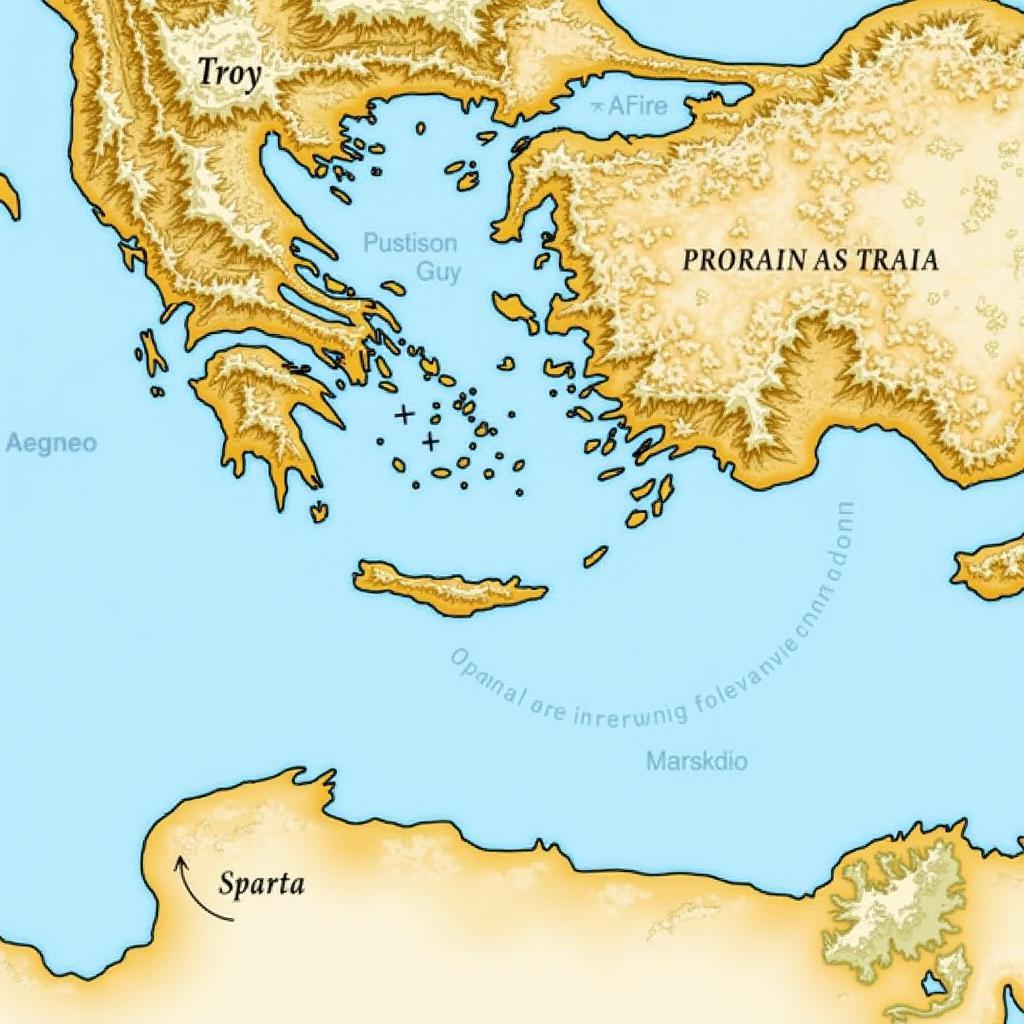The Trojan Horse. A name synonymous with cunning, deception, and ultimately, victory. This legendary artifact from the Trojan War, a conflict immortalized in Homer’s epic poems, continues to captivate our imaginations thousands of years later. But what is the true story behind the Trojan Horse? Was it merely a myth, or a clever military tactic that altered the course of history? Let’s delve into the fascinating world of ancient Greece and uncover the truth behind this epic feat.
The Trojan War: A Conflict of Gods and Mortals
Before we unravel the mystery of the Trojan Horse, we need to understand the context of the Trojan War. Legend has it that the war began with the abduction of Helen, the beautiful wife of King Menelaus of Sparta, by the Trojan prince Paris. This act ignited a conflict that pitted the Greeks against the Trojans in a bloody ten-year siege.
 Map of the Trojan War
Map of the Trojan War
The Greeks, led by the cunning King Agamemnon, faced fierce resistance from the Trojans, who were equally matched in skill and determination. The war raged on, with both sides suffering heavy losses and neither gaining a decisive advantage. It seemed as if the conflict would continue indefinitely, with no end in sight.
The Birth of a Strategy: The Trojan Horse is Conceived
As the war dragged on, the Greeks grew increasingly desperate to break the stalemate. It was then that Odysseus, the King of Ithaca known for his sharp intellect and cunning, devised a daring plan. He proposed building a colossal wooden horse, a symbol of peace offering, and presenting it to the Trojans as a gesture of surrender.
 Odysseus Planning the Trojan Horse
Odysseus Planning the Trojan Horse
However, this seemingly innocent gift would conceal a secret weapon: a group of elite Greek soldiers hidden within its hollow belly. Under the cover of night, these warriors would emerge from their hiding place and launch a surprise attack on the unsuspecting city of Troy.
A City Outwitted: The Fall of Troy
Despite initial skepticism, the Greeks embraced Odysseus’s audacious plan. They constructed the immense wooden horse, carefully crafting its exterior to resemble a sacred offering. Meanwhile, a select group of Greek warriors, led by the courageous Diomedes, stealthily took their positions within the horse’s hollow interior.
The Trojans, weary from years of war and eager to believe in a peaceful resolution, fell prey to the Greek deception. They interpreted the horse as a sign of their enemy’s surrender and a tribute to their strength. Overjoyed, they opened their fortified gates and, unaware of the danger that lurked within, pulled the colossal wooden horse into their city.
As night fell and the Trojans celebrated their perceived victory, the Greek warriors hidden within the horse silently emerged from their confinement. They overpowered the unsuspecting guards, opened the city gates for the waiting Greek army, and launched a surprise attack that threw the city into chaos. The Greeks, fueled by years of frustration and a thirst for revenge, unleashed their fury upon the unsuspecting city. Troy, once thought to be impenetrable, fell in a single night.
The Legacy of the Trojan Horse: A Tale for the Ages
The story of the Trojan Horse, whether entirely factual or embellished through time, holds a powerful place in our collective imagination. It serves as a potent reminder of the cunning of the human mind, the seductive nature of deception, and the unpredictable turns of fate that can shape the course of history.
The Trojan Horse has transcended its historical context to become a metaphor for any strategy that uses deceit to gain access to a seemingly impenetrable target. It’s a story that continues to intrigue, inspire, and caution us, proving that even the most formidable defenses can be breached with a combination of intelligence, strategy, and a touch of audacious deception.
FAQs: Unraveling the Mysteries of the Trojan Horse
- Was the Trojan Horse real? While the Trojan War is generally accepted as a historical event, the existence of the Trojan Horse itself is still debated. Archaeological evidence is inconclusive, and some scholars believe it may be a symbolic representation of a siege engine or a metaphor for a successful Greek strategy.
- How big was the Trojan Horse? Ancient accounts vary, but it’s estimated to have been between 15-50 feet tall, large enough to conceal a small group of soldiers.
- Why didn’t the Trojans destroy the horse? Some accounts suggest they were warned by prophets like Cassandra and Laocoon, but their pleas were ignored. Others believe the Trojans were blinded by their desire for peace and saw the horse as a religious offering.
- What happened to Helen of Troy? After the fall of Troy, she was reunited with her husband, Menelaus. However, her story varies in different versions of the myth.
- What lessons can we learn from the Trojan Horse? The story highlights the importance of critical thinking, questioning assumptions, and recognizing potential deception, even in times of apparent victory.
We encourage you to delve deeper into the epic tale of the Trojan Horse and the Trojan War. Our website offers a wealth of information on ancient history, mythology, and the fascinating stories that have shaped our world.
For any inquiries or assistance, please don’t hesitate to contact us:
Phone: 0772127271
Email: [email protected]
Address: QGM2+WX2, Vị Trung, Vị Thuỷ, Hậu Giang, Việt Nam.
Our dedicated customer support team is available 24/7 to assist you.